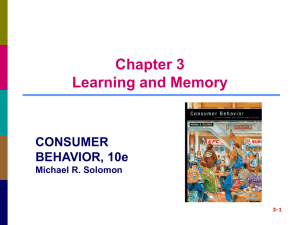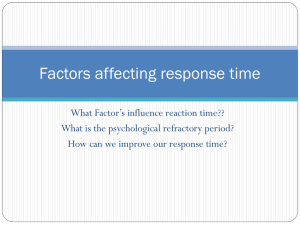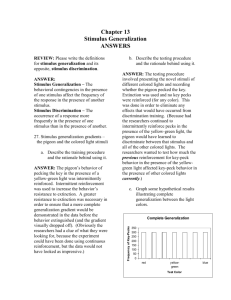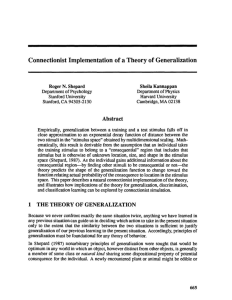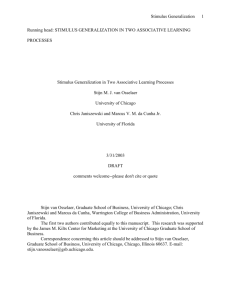StImuluS GeneralIzatIon and dIScrImInatIon
advertisement
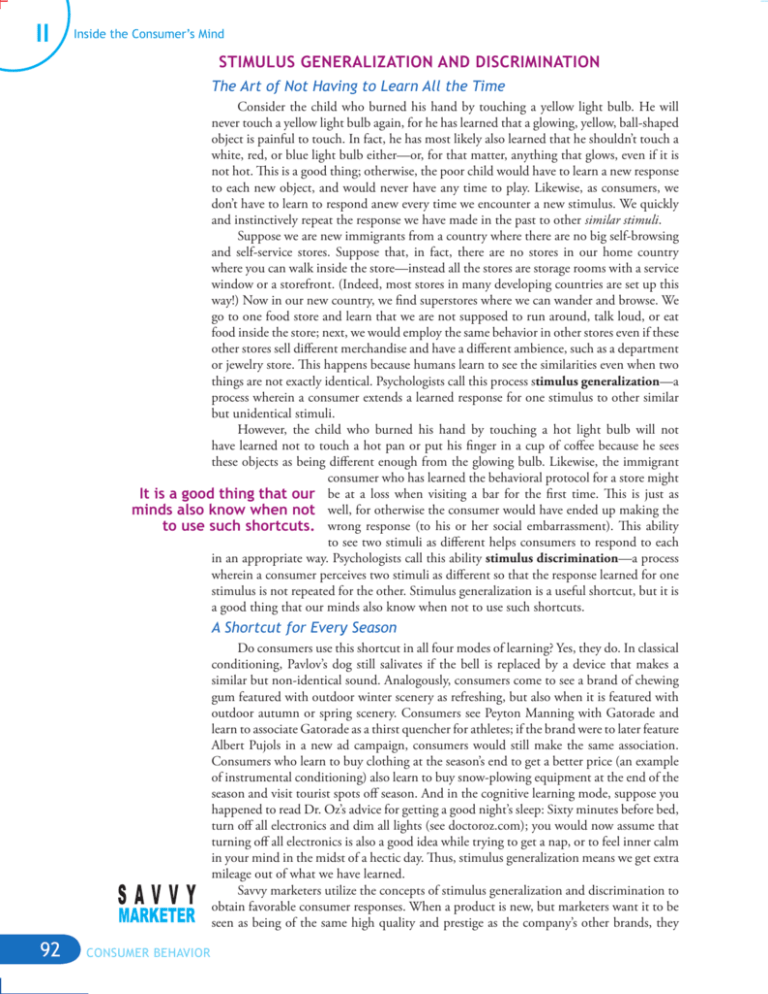
II Inside the Consumer’s Mind Stimulus Generalization and Discrimination The Art of Not Having to Learn All the Time Consider the child who burned his hand by touching a yellow light bulb. He will never touch a yellow light bulb again, for he has learned that a glowing, yellow, ball-shaped object is painful to touch. In fact, he has most likely also learned that he shouldn’t touch a white, red, or blue light bulb either—or, for that matter, anything that glows, even if it is not hot. This is a good thing; otherwise, the poor child would have to learn a new response to each new object, and would never have any time to play. Likewise, as consumers, we don’t have to learn to respond anew every time we encounter a new stimulus. We quickly and instinctively repeat the response we have made in the past to other similar stimuli. Suppose we are new immigrants from a country where there are no big self-browsing and self-service stores. Suppose that, in fact, there are no stores in our home country where you can walk inside the store—instead all the stores are storage rooms with a service window or a storefront. (Indeed, most stores in many developing countries are set up this way!) Now in our new country, we find superstores where we can wander and browse. We go to one food store and learn that we are not supposed to run around, talk loud, or eat food inside the store; next, we would employ the same behavior in other stores even if these other stores sell different merchandise and have a different ambience, such as a department or jewelry store. This happens because humans learn to see the similarities even when two things are not exactly identical. Psychologists call this process stimulus generalization—a process wherein a consumer extends a learned response for one stimulus to other similar but unidentical stimuli. However, the child who burned his hand by touching a hot light bulb will not have learned not to touch a hot pan or put his finger in a cup of coffee because he sees these objects as being different enough from the glowing bulb. Likewise, the immigrant consumer who has learned the behavioral protocol for a store might It is a good thing that our be at a loss when visiting a bar for the first time. This is just as minds also know when not well, for otherwise the consumer would have ended up making the to use such shortcuts. wrong response (to his or her social embarrassment). This ability to see two stimuli as different helps consumers to respond to each in an appropriate way. Psychologists call this ability stimulus discrimination—a process wherein a consumer perceives two stimuli as different so that the response learned for one stimulus is not repeated for the other. Stimulus generalization is a useful shortcut, but it is a good thing that our minds also know when not to use such shortcuts. A Shortcut for Every Season Do consumers use this shortcut in all four modes of learning? Yes, they do. In classical conditioning, Pavlov’s dog still salivates if the bell is replaced by a device that makes a similar but non-identical sound. Analogously, consumers come to see a brand of chewing gum featured with outdoor winter scenery as refreshing, but also when it is featured with outdoor autumn or spring scenery. Consumers see Peyton Manning with Gatorade and learn to associate Gatorade as a thirst quencher for athletes; if the brand were to later feature Albert Pujols in a new ad campaign, consumers would still make the same association. Consumers who learn to buy clothing at the season’s end to get a better price (an example of instrumental conditioning) also learn to buy snow-plowing equipment at the end of the season and visit tourist spots off season. And in the cognitive learning mode, suppose you happened to read Dr. Oz’s advice for getting a good night’s sleep: Sixty minutes before bed, turn off all electronics and dim all lights (see doctoroz.com); you would now assume that turning off all electronics is also a good idea while trying to get a nap, or to feel inner calm in your mind in the midst of a hectic day. Thus, stimulus generalization means we get extra mileage out of what we have learned. Savvy marketers utilize the concepts of stimulus generalization and discrimination to obtain favorable consumer responses. When a product is new, but marketers want it to be seen as being of the same high quality and prestige as the company’s other brands, they 92 CONSUMER BEHAVIOR Consumer learning, memory, and nostalgia give the new product the appearance of the familiar brand, by package similarity and the brand name. Thus, new flavors of soup, new varieties of pasta, and new versions of video games are given a brand family name and are packaged identically to the existing package. Store brands make their products resemble manufacturers’ brands, hoping consumers will engage in stimulus generalization. In contrast, when marketers want to attract a new set of consumers, they name the new brand by a different and unique name—for example, Eternity and Obsession colognes (both from Calvin Klein). 4 CONSUMER INFORMATION PROCESSING Memory and Remembering Inside th e S u pe r c o m pu t e r Whereas the other three models of learning are applicable to non-human creatures as well, only humans have the capacity for cognitive learning, because only humans have the capability to process information. Here is the phone number for University of Cambridge: 44 (0) 1223 337733; and for the Office of the Prime Minster of Canada: 613 992 4211; and, finally, for the White House: 202 456 1414. Can you memorize these? At least one of them? You are able to memorize the last one, or maybe even the middle number, right? This is because these are shorter, but also because they are only seven digits long (not counting the area code). Seven is also the number of digits (more exactly speaking, ‘seven plus or minus two’) a human can memorize at a time. Seven digits, seven letters, seven names, and so on. Psychologist George Miller has established through research that we are able to memorize seven bits of information, plus or minus two, at a time.5 When we combine bits of information and treat the combined entity itself as a unit, with a meaning of its own, then that becomes a new single bit of information. This combination of bits into a new unit is called chunking. Thus, 911 is a single bit or chunk that stands for the emergency phone number in the US and Canada (and in a few other countries such as El Salvador, Fiji, and Uruguay) and 999 in the U.K. We can memorize seven bits of information, make it into a unit, and then move on to memorizing a new set of seven bits of information. Our minds also are able to quickly form into chunks some simple multi-digit numbers such as 3000, 6666, etc. (London Business School has cleverly chosen its number to be 44 0 (20) 7000 7000!) Furthermore, words we are already familiar with form a unit, no matter how many letters they may have. Thus, President’s Delight as a brand name can be memorized quickly because both the words are already familiar. CB FYI Beauty of Mathematics Here is a treat for your appetite for cognitive learning. It is easy to memorize by pattern recognition, a cognitive process that entails e l a b o r a t i o n. 1 x 8+1 = 9 12 x 8+2 = 98 123 x 8+3 = 987 1234 x 8+4 = 9876 12345 x 8+5 = 98765 123456 x 8+6 = 987654 1234567 x 8+7 = 9876543 12345678 x 8+8 = 98765432 123456789 x 8+9 = 987654321 9 x 9 + 7 = 88 98 x 9 + 6 = 888 987 x 9 + 5 = 8888 9876 x 9 + 4 = 88888 98765 x 9 + 3 = 888888 987654 x 9 + 2 = 8888888 9876543 x 9 + 1 = 88888888 98765432 x 9 + 0 = 888888888 Powered by OM MY CB BOOK How Consumer Memory Works Pulp Fiction Bookpurses, Will You Remember Them? Pulp Fiction Bookpurses—the fun purses from Maddie Powers, made with vintage pulp-fiction book jackets with titles like Don’t Push Me Around and Boy Chaser. Will you remember this title, say, by tomorrow? Or, instead, will your memory fail you? Memory is a place in the human brain where information is processed and stored. It is like a warehouse that holds all we know and all we will ever know over our entire lifetimes. Memory refers to both this storage area and its stored contents. It is divided into three parts: sensory, short term, and long term. HUMAN PURSUIT OF HAPPINESS 93




